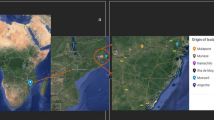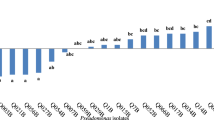Abstract
A genetically modified microorganism (GMM), Pseudomonas fluorescens SBW25 (lacZY and kanr-xylE), derived from a strain taken from the leaves of mature sugar beet (Beta vulgaris var. Amethyst), was released as a seed inoculum (ca 1×107 cfu/seed) to field-grown sugar beet in 1993 and 1994. The inoculum successfully colonized the roots and leaves of developing plants and survived in the phytosphere throughout the growing season, (270 days post release). Variation in the population dynamics of the GMM colonizing the immature leaf habitat was observed over two consecutive seasons. In 1993, the GMM represented a minor component of the pseudomonad community in emerging seedlings (<6%), (4×104 cfu g−1, coefficient of variation, CV=7%) whereas, in 1994, plants of similar size were colonized by significantly greater numbers of the GMM (1.1 × 106 cfu g−1, CV=10%) (81% of the total pseudomon-ads) reaching maximum densities 102 days after release. Limited dispersal of the GMM from sugar beet to other plants species was recorded. Although GMMs could not be detected in soil (<1 cfu g−1) or on overwintering plant tissue (<20 cfu g−1) GMMs persisted and colonised plants grown the following season. No transfer of the marker genes to other indigenous microorganisms was recorded.
This is a preview of subscription content, access via your institution
Access options
Subscribe to this journal
Receive 12 print issues and online access
$209.00 per year
only $17.42 per issue
Buy this article
- Purchase on Springer Link
- Instant access to full article PDF
Prices may be subject to local taxes which are calculated during checkout
Similar content being viewed by others
References
Wilson, M. and Lindow, S.E. 1993. Release of recombinant microorganisms. Annu. Rev. Microbiol. 47: 913–944.
Cory, J.S., Hirst, M.L., Williams, T., Hails, R.S., Goulson, D., Green, B.M., Carty, T.M., Possee, R.D., Cayley, J. and Bishop, D.H.L. 1994. Field trial of a genetically improved baculovirus insecticide. Nature 370: 138–140.
Lindow, S.E., Knudsen, G.R., Seidler, R.J., Walter, M.V., Lambou, V.W., Amy, P.S., Schmedding Prince, V. and Hern, S. 1988. Aerial dispersal and epiphytic survival of Pseudomonas syringae. Appl. Eviron. Microbiol. 54: 1557–1563.
Drahos, D.J. 1991. Field testing of genetically engineered microorganisms. Advances in Biotechnology 9: 157–177.
Tiedje, J.M., Colwell, R.K., Grossman, Y.L., Hodgson, R.E., Lenski, R.E., Mack, R.N. and Regal, P.J. 1989. The planned introduction of genetically modified organisms: ecological considerations and recommendations. Ecology 70: 298–315.
Drahos, D.J., Barry, G.F., Hemmin, B.C., Brandt, E.J., Kline, E.L., Skipper, H.D., Kluepfel, D.A., Gooden, D.T. and Hughes, T.A. 1992. Spread and survival of genetically marked bacteria in soil, p. 147–159. In: Release of genetically engineered and other microorganisms, Fry, J. C. and Day, M. J. (Eds.). Cambridge University Press.
Kluepfel, D.A., Kline, E.L., Skipper, H.D., Hughes, T.A., Gooden, D.T., Barry, G.F., Hemmings, B.C. and Brandt, E.J. 1991. The release and tracking of genetically engineered bacteria in the environment. Phytopathology 81: 348–352.
Ryder, M. 1994. Key issues in the deliberate release of genetically manipulated bacteria. FEMS Microbiol. Ecol. 15: 139–146.
Parke, J.L., Zablotowicz, R.M. and Rand, R.E. 1992. Tracking a lacZY marked strain of Pseudomonas fluorescens in a Wisconsin field trial. Phytopathology 82: 1177–1178.
Lindemann, J. and Suslow, T.V. 1987. Competition between ice nucleation active wild type and ice nucleation deficient deletion mutant strains of Pseudomonas syringae and Pseudomonas fluorescens biovar I and biological control of frost injury on strawberry blossoms. Phytopathology 77: 882–886.
Shaw, J.J., Dane, F., Geiger, D. and Kloepper, J.W. 1992. Use of bioluminescence for detection of genetically engineered microorganisms released into the environment. Appl. Environ. Microbiol. 58: 267–273.
Hirano, S.S. and Upper, C.D. 1993. Dynamics, Spread, and persistence of a single genotype of Pseudomonas syringae relative to those of its conspecifics on populations on snap bean leaflets. Appl. Eviron. Microbiol. 59: 1082–1091.
Thompson, I.P., Bailey, M.J., Fenlon, J.S., Fermor, T.R., Lilley, A.K., Lynch, J.M., McCormack, P.J., McQuilken, M., Purdy, K.J., Rainey, P.B. and Whipps, J.M. 1993. Quantitative and qualitative seasonal changes in the microbial community from the phyllosphere of sugar beet (Beta vulgaris). Plant and Soil 150: 177–191.
Thompson, I.P., Bailey, M.J., Ellis, R.J. and Purdy, K.J. 1993. Subgrouping of bacterial populations by cellular fatty acid composition. FEMS Microbiol. Ecol. 102: 75–84.
Thompson, I.P., Bailey, M.J., Ellis, R.J., Lilley, A.K., McCormack, P.J., Purdy, K.J. and Rainey, P.B. 1995. Short term community dynamics in the phyllosphere Microbiology of field grown sugar beet. FEMS Microbiol. Ecol. 16: 205–212.
Rainey, P.B., Bailey, M.J. and Thompson, I.P. 1994 Phenotypic and geno-typic diversity of fluorescent pseudomonads isolated from field grown sugar beet. Microbiology 140: 2315–2331.
Bailey, M.J., Lilley, A.K., Thompson, I.P., Rainey, P.B. and Ellis, R.J. 1995. Site directed chromosomal marking of a fluorescent pseudomonad isolated from the phytosphere of sugar beet; stability and potential for marker gene transfer. Molec. Ecol. In press.
Drahos, D.J., Hemming, B.C. and McPherson, S. 1986. Tracking recombinant organisms in the environment: beta-galactosidase as a selectable, non-antibiotic marker for fluorescent pseudomonads. Bio/Technology 4: 439–443.
Barry, G.F. 1988. A broad host range shuttle system for gene insertion into the chromosome of Gram-negative bacteria. Gene 71: 75–84.
Rainey, P.B. and Bailey, M.J. 1995. Physical and genetic map of the Pseudomonas fluorescens SBW25 chromosome. Molec. Microbiol. In press.
De Leij, F.A.A.M., Bailey, M.J., Lynch, J.M. and Whipps, J.M. 1993. A simple most probable number technique for the sensitive recovery of a genetically engineered Pseudomonas aureofaciens from soil. Lett. Appl. Microbiol. 16: 307–310.
Bramwell, P.A., Barallon, R.V., Rogers, H.J. and Bailey, M.J. 1995. Extraction and PCR amplification of DNA from the rhizoplane, p. 36–55. In: Molecular Microbial Ecology Manual. Akkermans, A. D. L., Van Elsas, J. D. and De Bruijn, F. J. (Eds.). Kluwer Academic Publishers.
Thompson, I.P., Ellis, R.J. and Bailey, M.J. 1995. Autecology of a genetically modified fluorescent pseudomonad on sugar beet. FEMS Microbiol. Ecol. 17: 1–14.
Ellis, R.J., Thompson, I.P. and Bailey, M.J. 1995. Metabolic profiling as a means of characterising plant-associated microbial communities. FEMS Microbiol. Ecol. 16: 9–18.
De Leij, F.A.A.M., Sutton, E.J., Whipps, J.M. and Lynch, J.M. 1994. Spread and survival of a genetically modified Pseudomonas aureofaciens in the phytosphere of wheat and in soil. Appl. Soil. Ecol. 1: 207–218.
Anon. 1995. Risk assessment and genetically modified microorganisms: Final phylloplane report. Research report no. 5, Department of the Environment, London.
Anon. 1995. Risk assessment and genetically modified microorganisms: Final rhizosphere report. Research report no. 6, Department of the Environment, London.
Anon. 1995. Risk assessment and genetically modified microorganisms: Final release report. Research report no. 7, Department of the Environment, London.
De Leij, F.A.A.M., Sutton, E.J., Whipps, J.M., Fenlon, J.S. and Lynch, J.M. 1995. Field release of a genetically modified Pseudomonas fluorescens on wheat: establishment, survival and dissemination. Bio/Technology 13: xxx–xxx.
O'Sullivan, D.B. and O'Gara, F. 1992. Traits of fluorescent Pseudomonas spp. involved in suppression of plant root pathogens. Microbiol. Rev. 56: 662–676.
Lenski, R.E. 1991. Quantifying fitness and gene stability in micro-organisms, p. 173–192. In: Assessing Ecological Risks of Biotechnology. Grinzburg, L. R. (Ed.). Butterworth-Heinemann, Boston.
Hirano, S.S., Nordheim, E.V., Arny, D.C. and Upper, C.D. 1982. Lognormal distribution of epiphytic bacterial populations on leaf surfaces. Appl. Environ. Microbiol. 44: 695–700.
Lilley, A.K., Fry, J.C., Day, M.J. and Bailey, M.J. 1994. In situ transfer of an exogenously isolated plasmid between indigenous donor and recipient Pseudomonad spp in sugar beet rhizosphere. Microbiology 140: 27–33.
Piper, K.R., Beck von Bodman, S. and Farrand, S.K. 1993. Conjugation of Agrobacterium tumefaciens regulates Ti plasmid transfer by autoinduction. Nature 362: 448–450.
Kidambi, S.P., Ripp, S. and Miller, R.V. 1994. Evidence for phage-mediated gene transfer among Pseudomonas aeruginosa strains on the phylloplane. Appl. Environ. Microbiol. 60: 496–500.
Wilson, M. and Lindow, S.E. 1994. Inoculum density dependent mortality and colonisation of the phyllosphere by Pseudomonas syringae. Appl. Environ. Microbiol. 60: 2232–2237.
Wilson, M. and Lindow, S.E. 1993. Effect of phenotypic plasticity on epiphytic survival and colonisation by Pseudomonas syringae. Appl. Environ. Micro. 59: 410–416.
Rainey, P.B., Moxon, E.R. and Thompson, I.P. 1994. Intraclonal polymorphism in bacteria, p. 263–293. In: Advances in Microbial Ecology. Jones, J. G. (Ed.). Plenum Press, London
Author information
Authors and Affiliations
Corresponding author
Rights and permissions
About this article
Cite this article
Thompson, I., Lilley, A., Ellis, R. et al. Survival, Colonization and Dispersal of Genetically Modified Pseudomonas fluorescens SBW25 in the Phytosphere of Field Grown Sugar Beet. Nat Biotechnol 13, 1493–1497 (1995). https://doi.org/10.1038/nbt1295-1493
Received:
Accepted:
Issue Date:
DOI: https://doi.org/10.1038/nbt1295-1493
This article is cited by
-
Obligate cross-feeding expands the metabolic niche of bacteria
Nature Ecology & Evolution (2021)
-
Beneficial microorganisms for soybean (Glycine max (L.) Merr), with a focus on low root-zone temperatures
Plant and Soil (2015)
-
Risk assessment for engineered bacteria used in biocontrol of fungal disease in agricultural crops
Plant and Soil (2005)
-
Monitoring population size, activity, and distribution of gfp-luxAB-tagged Pseudomonas fluorescens SBW25 during colonization of wheat
Microbial Ecology (2001)



